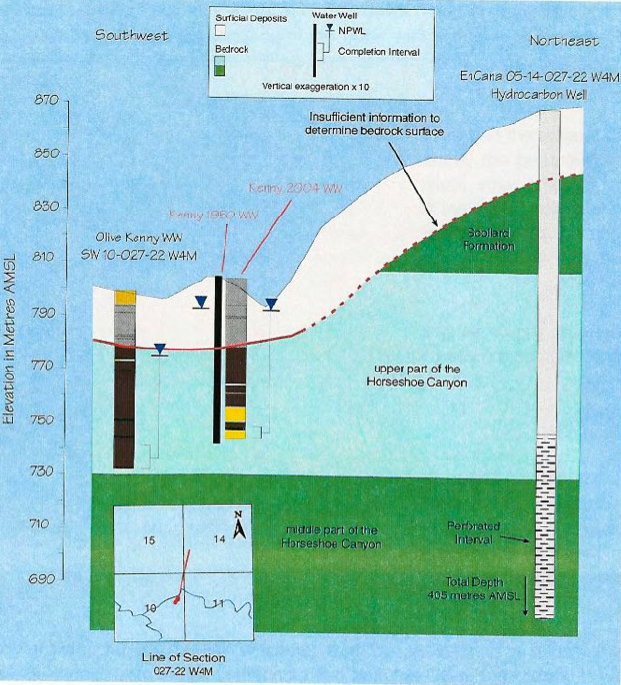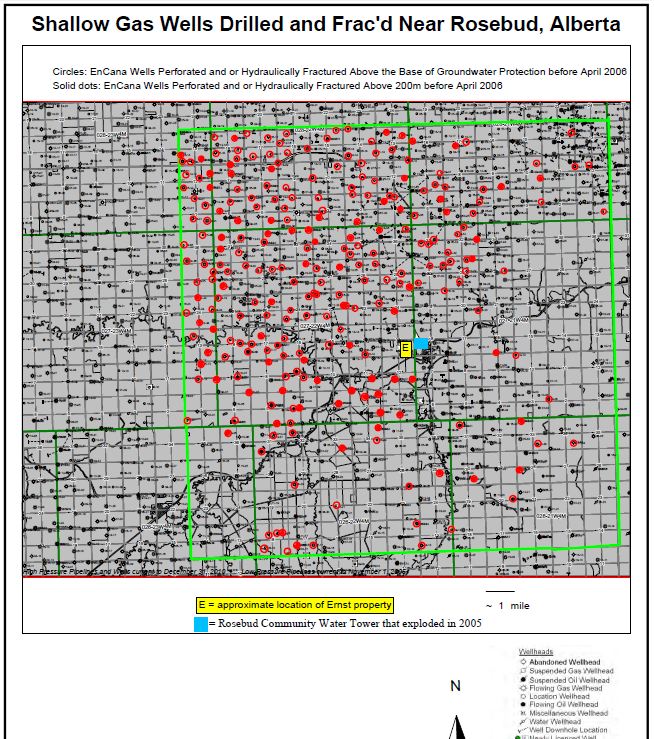[Refer first to:
Encana intentionally frac’d drinking water aquifers at Pavillion, Wyoming:


Encana intentionally frac’d drinking water aquifers and hundreds of sands and CBM wells above the Base of Groundwater Protection at Rosebud, Alberta:


Encana’s 5-14 gas well fractured repeatedly directly, intentionally, illegally into Rosebud’s drinking water aquifers. Diagram from January 2005 report for Encana by HCL.
Below, Encana’s gas wells (targeting shallow sands and coals) fractured above the Base of Groundwater Protection, or in other words, where the fresh water is (red dots) at Rosebud:

2014: Frac’ing and Lies Heating up in Manitoba: Oil & Gas Review 2014
Above two snaps from 2012 Presentation by Michelle P.B. Nicolas and John N. Fox, Manitoba Innovation, Energy and Mines

Snap above from 2008 Presentation by Michelle P.B. Nicolas and James D. Bamburak
Manitoba’s Shallow Unconventional Shale Gas Project by the Manitoba Geological Survey, 2008 to current
2009: A Primer for Understanding Canadian Shale Gas – Energy Briefing Note
***
Industry is targeting, will and or did target shallow “biogenic” shales in Quebec, Ontario, Alberta, Saskchewan, Nova Scotia and New Brunswick.
***
Test aims to identify shale gas hazard in groundwater Press Release by University of Edinburgh, April 21, 2016
A test has been developed to check for contamination of shallow groundwater from unconventional gas extraction techniques, such as fracking.
The development could help monitor the safety of shale gas and coal bed methane extraction, which has sparked debate because of the perceived risks of water contamination.
[That’s a propaganda industry statement, word for word, used year after year, to lie to concerned community after concerned community. Are researchers credible when they smear the many proven cases of water contamination from unconventional oil and gas development? What’s the intent of their new test? Con the Scots and force fracing on them by regurgitating industry propaganda that fracing is safe?]
…
Coal bed methane is extracted from deep coal seams by drilling into the coal to reduce the pressure and release gas. [Incorrect. Refer to references top of this post. CBM, NGC, CSG is extracted from many depths, including extremely shallow coals where companies intentionally target “naturally occurring biogenic” gas, sometimes intentionally directly fracing drinking water sources (Pavillion, Wyoming and Rosebud, Alberta two proven examples)]
The need for such a test was highlighted following allegations in the US that, following fracking operations, drinking water had become contaminated with large amounts of methane from deep below ground.
Groundwater often contains methane gas from shallow natural sources, which is harmless in small quantities. The researchers have developed a new way to fingerprint methane gas by identifying tiny traces of inactive natural gases, known as noble gases. These fingerprints vary depending on the origin and depth of the methane, and enable scientists to pinpoint its source.
[A few Reality Checks, there are countless more:

***

Slides from Ernst presentations
…
In its letter to The Tyee, the regulator inferred that gas in groundwater “is a common natural occurrence.”
Yet the best industry data suggests that as of 2006, only 0.1812 per cent — or fewer than 1,000 wells out of the province’s 500,000 groundwater wells (industry operates nearly 50,000) — show evidence of methane contamination.
Isotopic fingerprinting can precisely identify whether the gas comes from industry activity or Mother Nature. But the forensic science tool is not widely employed by oil and gas regulators.

Slide from Ernst presentations
End Reality Check]
The researchers, from the Universities of Edinburgh and Glasgow and the Scottish Universities Environmental Research Centre, have recorded these unique fingerprints in a number of exploratory shale gas and coal bed methane wells from around the UK. They are presenting these findings today (Friday) at the European Geosciences Union Conference in Vienna.
The fingerprint analysis can be used to determine the origin of methane at exploration sites. If levels of methane in groundwater are found to have changed following exploration activity, and the gas is traced to exploration or extraction activity, appropriate action can be taken.
Scientists developed the test by adapting a technique used for monitoring potential leaks of carbon dioxide gas from storage sites deep underground.
Dr Stuart Gilfillan, of the University of Edinburgh’s School of GeoSciences, who led the project, said: “Creating this fingerprint test [Refer below to Dr. Karlis Muehlenbachs’ isotopic fingerprinting test he developed in the 90’s in Alberta] will enable gas exploration and extraction to be carried out responsibly and should help address public concerns over this technology. It is important that careful monitoring of methane levels in nearby waters is carried out when commercial extraction begins.”
###
The project was supported by the Natural Environment Research Council, the Scottish Government and the University of Edinburgh. [Emphasis added]
Test aims to identify shale gas hazard in groundwater by University of Edinburgh, April 22, 2016, ScienceDaily
A test has been developed to check for contamination of shallow groundwater from unconventional gas extraction techniques, such as fracking.
The development could help monitor the safety of shale gas and coal bed methane extraction [but, will industry allow it? The testing technique originally developed by Dr. Karlis Muehlenbachs has been available since the 90’s, but industry refuses to comprehensively test and make public such vital data on energy wells, even when intentionally fracing drinking water aquifers. Why? Does the data prove industry is contaminating groundwater at an alarming rate?], which has sparked debate because of the perceived [or actual? How many thousands of water wells have been contaminated by conventional and unconventional oil and gas? “Perceived” is industry’s beloved way to belittle proven cases of drinking water contamination by fracing] risks of water contamination.
Methods used for shale gas extraction include hydraulic fracturing, commonly known as fracking, in which shale rocks below ground are split with high-pressure fluids to release gas that is recovered for fuel. Coal bed methane is extracted from deep [!!!] coal seams by drilling into the coal to reduce the pressure and release gas.
The need for such a test was highlighted following allegations in the US that, following fracking operations, drinking water had become contaminated with large amounts of methane from deep below ground.
Groundwater often contains methane gas from shallow natural sources, which is harmless in small quantities. The researchers have developed a new way to fingerprint methane gas by identifying tiny traces of inactive natural gases, known as noble gases. These fingerprints vary depending on the origin and depth of the methane, and enable scientists to pinpoint its source.
The researchers, from the Universities of Edinburgh and Glasgow and the Scottish Universities Environmental Research Centre, have recorded these unique fingerprints in a number of exploratory shale gas and coal bed methane wells from around the UK. They are presenting these findings at the European Geosciences Union Conference in Vienna.
The fingerprint analysis can be used to determine the origin of methane at exploration sites. If levels of methane in groundwater are found to have changed following exploration activity, and the gas is traced to exploration or extraction activity, appropriate action can be taken.
Scientists developed the test by adapting a technique used for monitoring potential leaks of carbon dioxide gas from storage sites deep underground.
Dr Stuart Gilfillan, of the University of Edinburgh’s School of GeoSciences, who led the project, said: “Creating this fingerprint test will enable gas exploration and extraction to be carried out [Is that the real reason the test was created? To enable fracing in Scotland when so many are saying no to it?] responsibly and should help address public concerns over this technology. It is important that careful monitoring of methane levels in nearby waters is carried out when commercial extraction begins.” [Emphasis added]
[Refer also to:

Chapter 10: Dr. Karlis Muehlenbachs and Alberta Energy Regulator Bulletin GB-99-06
Dr. Karlis Muehlenbachs, geoscientist at the University of Alberta, developed the technique of sourcing industry-caused leaks, namely Surface Casing Vent Flow (SCVF) and Gas Migration (GM), using stable carbon isotopic analysis or isotopic fingerprinting of the gases.
In 1999, the Alberta energy regulator, then the Alberta Energy and Utilities Board (EUB), now the Energy Resources Conservation Board (ERCB32), released Bulletin GB-99-06 recommending his technique: “Therefore, the [EUB] and Saskatchewan Energy and Mines (SEM) are prepared to accept the use and validity of this method on a site specific basis. Development and availability of high quality regional databases, containing interpreted analytical and geological information, are necessary prerequisites to defensible, extrapolated diagnoses for SCVF/GM problems. The need to involve qualified expertise is also necessary.” 33
In 2007, the EUB presented that the “shallower, upper part” of industry well bores (where much of the biogenic gas is) have “higher potential for leakage” than deep production zones:
A study by GSI Environmental Inc. and Cabot Oil and Gas Corp. released in May 2013 on the methane migration problems in Susquehanna County, Pennsylvania, “suggests that gases present in local water wells are most consistent with Middle and Upper Devonian gases sampled in the annular spaces of local gas wells, as opposed to Marcellus production gases.”35 10
In 2011, Dr. Muehlenbachs presented in Washington (slides included below) that more than 70% of casing gases come from intermediate layers of energy well bores, not the target zone:36

Industry reports that the methane they are targeting in shallow shales, coals and tight sands is biogenic or “natural”; 7/7 of the industry coalbed methane (CBM) wells (completed between about 250 and 730 m below surface) in Alberta studied by the ERCB contained biogenic methane.37


